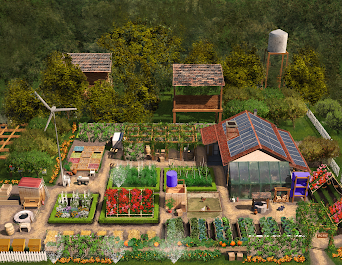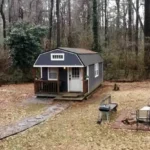
In today’s world, sustainable living has become more than just a buzzword. It’s a lifestyle that many people are adopting to reduce their carbon footprint and live in harmony with nature. One of the best ways to achieve this is by growing your own fresh produce. Not only does it promote healthy eating, but it also reduces the need for transportation and packaging, which in turn reduces carbon emissions.
But what if you live off the grid or in an urban area with limited space? Fear not, because with a bit of creativity and resourcefulness, you can still enjoy homegrown fruits and vegetables. In this article, we’ll share some tips on how to grow fresh produce off the grid, whether you have a backyard, a balcony, or just a windowsill. So, let’s get started on your journey towards sustainable living!
Benefits of growing fresh produce off the grid
Growing your own fresh produce has many benefits. First and foremost, it promotes healthy eating. When you grow your own fruits and vegetables, you know exactly what goes into them. You can avoid harmful pesticides and chemicals, and you can harvest them at peak ripeness for maximum flavor and nutrition.
Plus, it’s a great way to save money on groceries. Instead of buying produce from the store, you can grow your own and enjoy it for free.
But growing your own produce off the grid has even more benefits. For one, it reduces your carbon footprint. When you grow your own food, you eliminate the need for transportation and packaging, which are major sources of carbon emissions. Plus, it allows you to live in greater harmony with nature. By growing your own food, you become more connected to the land and the cycles of the seasons.
It’s a rewarding experience that can help you feel more grounded and in touch with the earth.
Choosing the right location for your sustainable garden

When it comes to growing your own fresh produce off the grid, location is key. You’ll want to choose a spot that gets plenty of sunlight, has good soil, and is protected from wind and other elements. If you have a backyard, you’re in luck. You can create a traditional garden bed or even a raised garden bed.
Raised garden beds are great because they allow you to control the soil quality and drainage. Plus, they’re easier on your back since you don’t have to bend over as much. ( I used to set up gardens for elderly and disabled, and raised beds worked a treat)
If you don’t have a backyard, don’t worry. You can still grow fresh produce off the grid. If you have a balcony or patio, you can create a container garden. All you need is a few pots, some soil, and some seeds. Make sure to choose pots that are large enough to accommodate the roots of your plants. You can also hang planters from your balcony railing to maximize space.
If you don’t have any outdoor space at all, you can still grow fresh produce off the grid. All you need is a windowsill and some sunlight. Choose small plants like herbs or cherry tomatoes that don’t require a lot of space. You can also use a hydroponic system to grow fresh produce indoors without soil.
Understanding soil and composting
Good soil is essential for growing healthy plants. When it comes to off the grid gardening, you’ll want to focus on improving the soil quality naturally. This means using compost instead of synthetic fertilizers. Composting is easy and can be done in a variety of ways. You can create a compost pile in your backyard using organic matter like leaves, grass clippings, and food scraps. You can also use a compost tumbler or a worm farm if you have limited space.
Composting has many benefits. It enriches the soil with nutrients, improves soil structure, and reduces waste. Plus, it’s free and easy to do. All you need is some organic matter and a little bit of patience. Once your compost is ready, you can use it to improve your soil and provide your plants with the nutrients they need to thrive.
Selecting the best seeds for your garden
Choosing the right seeds for your off the grid garden is important. You’ll want to select seeds that are well-suited to your climate and growing conditions. Look for seeds that are labeled as heirloom or open-pollinated. These types of seeds are more diverse and adaptable than hybrid seeds. They also tend to produce fruits and vegetables with more flavor and nutrition which is great.
When selecting seeds, pay attention to the days to maturity. This is the time it takes for a plant to produce fruit or vegetables after it’s been planted. If you live in a cooler climate, you’ll want to choose seeds with a shorter days to maturity so that you can harvest your produce before the first frost. If you live in a warmer climate, you can choose seeds with a longer days to maturity.
Planning your garden layout
Once you’ve selected your seeds, it’s time to plan your garden layout. This is where you’ll decide where to plant each type of vegetable or fruit. You’ll want to consider factors like sunlight, soil quality, and water access. You’ll also want to think about companion planting.
Companion planting is the practice of planting certain plants together that benefit each other. For example, planting marigolds near your tomato plants can help repel pests.
When planning your garden layout, make sure to leave enough space between plants. Overcrowding can lead to disease and reduced yields. You’ll also want to consider how you’ll water your garden. If you don’t have access to a hose, you may need to use a watering can or a drip irrigation system.
The book below gives great detail for your off grid survival garden.
Maintaining your garden
Maintaining your off the grid garden is essential for its success. This means watering your plants regularly, weeding, and checking for pests and disease. You’ll also want to prune your plants as needed to promote healthy growth. Make sure to remove any dead or diseased leaves and fruit to prevent the spread of disease.
When it comes to watering, it’s important to do it correctly. Over watering can lead to root rot, while under watering can cause your plants to wilt and die. You’ll want to water your plants deeply and infrequently, rather than giving them a little every day. This encourages deep root growth and helps your plants survive periods of drought.
Harvesting and storing your produce
Once your off grid garden starts producing, it’s time to harvest your fresh produce. You’ll want to pick your fruits and vegetables when they’re ripe for the best flavor and nutrition. Tomatoes, for example, should be picked when they’re fully red and slightly soft to the touch. Peppers should be picked when they’re firm and brightly colored.
After you’ve harvested your produce, it’s important to store it correctly. Some fruits and vegetables, like tomatoes and avocados, should be stored at room temperature until they’re ready to eat. Others, like leafy greens and herbs, should be stored in the fridge to keep them fresh. Make sure to store your produce in a cool, dry place away from direct sunlight.
Cooking and preserving your fresh produce
Once you’ve harvested your fresh produce, it’s time to enjoy it. There are many ways to cook and preserve fresh produce off the grid. You can make salads, soups, stews, and stir-fries with your fresh vegetables. You can also preserve your excess produce by canning, freezing, or dehydrating it. Canning is a great way to preserve fruits and vegetables for the long term. Freezing is a good option for produce that you’ll use within a few months. Dehydrating is another good option for fruits and vegetables that you want to use in trail mix or other snacks.
Sustainable living beyond your garden
Growing fresh produce off the grid is just one way to live a sustainable lifestyle. There are many other things you can do to reduce your carbon footprint and live in greater harmony with nature. You can reduce your energy usage by using renewable energy sources like solar or wind power. You can also reduce your waste by composting, recycling, and using reusable bags and containers. You can even reduce your water usage by collecting rainwater and using it to water your plants.
In conclusion, I would like to emphasize that growing fresh produce off the grid is a great way to live a sustainable lifestyle. Not only does it promote healthy eating, but it also reduces your carbon footprint and allows you to live in greater harmony with nature.
With a bit of creativity and resourcefulness, you can grow fresh produce no matter where you live. By choosing the right location, understanding soil and composting, selecting the best seeds, planning your garden layout, and maintaining your garden, you can enjoy a bountiful harvest of homegrown fruits and vegetables.








Your blog is a standout in the virtual space, offering a distinct blend of expertise and creativity. It would be intriguing to see you scrutinize how these ideas align with current movements, such as AI or sustainable living. Your knack for decoding complex topics is impressive. Thanks for always delivering such informative content—I’m excited for your next post!
there
there